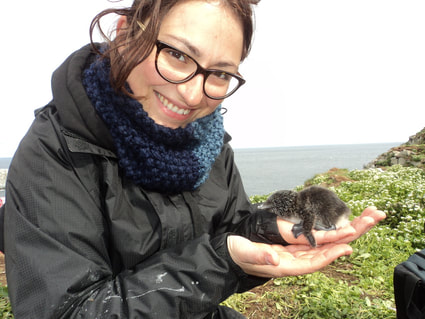
Adaptation is often the first step towards genetic differentiation of populations, and what leads to speciation in many cases. Adaptation enables organisms to cope with new conditions, or to occupy new niches.
Therefore, investigating how organisms adapt, and the genetic mechanisms behind this process, provides insights into how species form and how differences among species are maintained. Studying adaptation is also important from a conservation perspective: understanding how species adapted in the past will help us predict how species will respond to environmental change.
My research revolves around three main questions:
1) what is the genomic and physiological basis of adaptive traits?
2) How do adaptive traits evolve and are maintained in a population?
3) What are the relative roles of structural variation and genome structure in adaptation?
To address these questions I use a combination of genomic approaches, including population and comparative genomics, bioinformatics, and research in the field and the lab, in a variety of vertebrate taxa.
Genomic of adaptation in the Arctic
Murres (Uria spp.) are a central components of the arctic ecosystem and face many anthropogenic challenges, including climate change, harvest, and oil pollution. To understand the potential to adapt to future climate change, I investigate population differentiation and genomic signatures of local adaptation in common and thick-billed murres using genomic tools. The results from my work have management and conservation application, in that they provide the basis for the development of a panel of genetic markers able to assign hunted murres to their respective colony of origin, thus allowing us to assess the impact of harvesting in different areas of the Atlantic. My research on an adaptive dimorphism in Atlantic common murres is also providing insights into the genomic and physiological basis of thermal adaptation in birds, and the role of genomic structural variants in the evolution and maintenance of balanced dimorphisms.
@FriesenLab
The genomic landscape of clinal adaptive differentiation
The Atlantic silverside (Menidia mendia) is a small estuarine fish distributed along the Atlantic coast of North America, from Georgia to Quebec. The species is well known for its remarkable adaptive differences along the cline in response to variation in temperature and growing season length, and represents an ideal system to study the genomic basis and architecture of adaptive traits. I have developed genomic resources for the Atlantic silverside, including a reference genome, and use low-coverage whole genomes, linked reads, and long reads to characterize the genomic architecture of adaptive traits and to understand the role of gene flow and other evolutionary factors promoting the evolution of concentrated genomic architectures, i.e. blocks of genomic differentiation.
@TherkildsenLab
The genomic and physiological basis of desert adaptations in Peromyscus mice
The cactus mouse (Peromyscus eremicus) inhabits the deserts of North America in the south-west and shows striking adaptations to extreme heat and dehydration. In the lab, for example, cactus mice can survive with minimal signs of stress to lack of water and high temperatures for longer than 3 days. For comparison, a human would likely die in less than 3 days under those conditions! I have worked on the genomic and physiological basis of desert adaptation in the cactus mouse and other Peromyscus mice using whole genome sequences and population and comparative genomics approaches.
@MacManesLab
The genomic basis and architecture of migration, reproductive strategies, and local adaptation in Sockeye and Kokanee salmon
More details coming soon.
@RusselloLab
Murres (Uria spp.) are a central components of the arctic ecosystem and face many anthropogenic challenges, including climate change, harvest, and oil pollution. To understand the potential to adapt to future climate change, I investigate population differentiation and genomic signatures of local adaptation in common and thick-billed murres using genomic tools. The results from my work have management and conservation application, in that they provide the basis for the development of a panel of genetic markers able to assign hunted murres to their respective colony of origin, thus allowing us to assess the impact of harvesting in different areas of the Atlantic. My research on an adaptive dimorphism in Atlantic common murres is also providing insights into the genomic and physiological basis of thermal adaptation in birds, and the role of genomic structural variants in the evolution and maintenance of balanced dimorphisms.
@FriesenLab
The genomic landscape of clinal adaptive differentiation
The Atlantic silverside (Menidia mendia) is a small estuarine fish distributed along the Atlantic coast of North America, from Georgia to Quebec. The species is well known for its remarkable adaptive differences along the cline in response to variation in temperature and growing season length, and represents an ideal system to study the genomic basis and architecture of adaptive traits. I have developed genomic resources for the Atlantic silverside, including a reference genome, and use low-coverage whole genomes, linked reads, and long reads to characterize the genomic architecture of adaptive traits and to understand the role of gene flow and other evolutionary factors promoting the evolution of concentrated genomic architectures, i.e. blocks of genomic differentiation.
@TherkildsenLab
The genomic and physiological basis of desert adaptations in Peromyscus mice
The cactus mouse (Peromyscus eremicus) inhabits the deserts of North America in the south-west and shows striking adaptations to extreme heat and dehydration. In the lab, for example, cactus mice can survive with minimal signs of stress to lack of water and high temperatures for longer than 3 days. For comparison, a human would likely die in less than 3 days under those conditions! I have worked on the genomic and physiological basis of desert adaptation in the cactus mouse and other Peromyscus mice using whole genome sequences and population and comparative genomics approaches.
@MacManesLab
The genomic basis and architecture of migration, reproductive strategies, and local adaptation in Sockeye and Kokanee salmon
More details coming soon.
@RusselloLab
